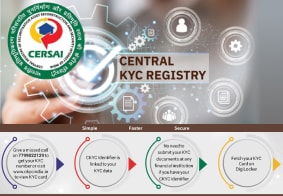CKYC Registry
-
Customer Service Contact us Service request Locate a branch
Find all the help you need
Scan the QR, get our app, and find help on your fingertips

Help CenterSupport topics, Contact us, FAQs and more
-
Login
Are you ready for an upgrade?
Login to the new experience with best features and services
-
Login
Are you ready for an upgrade?
Login to the new experience with best features and services
- Accounts
-
Deposits
IDFC FIRST Bank Deposits
View all Deposits -
Loans
IDFC FIRST Bank Loans
View all Loans - Wealth & Insure
-
Payments
IDFC FIRST Bank Payments
View all Payments -
Cards
IDFC FIRST Bank Cards
View all Cards - Blogs
- Corporate Account
-
Cash Management Services
IDFC FIRST Bank Cash Management Services
View all Cash Management Services - Supply Chain Finance
-
Corporate Lending
IDFC FIRST Bank Lending
View all -
Treasury
IDFC FIRST Bank Treasury
See more details - NBFC Financing
Support topics, Contact us, FAQs and more
- IDFC FIRST Bank Accounts
-
Savings Account
-
Corporate Salary
Account -
Senior Citizens
Savings Account -
First Power
Account -
Current Account
-
NRI Savings
Account -
TASC Institutional
Account -
Savings Account
Interest Calculator
- IDFC FIRST Bank Deposits
-
Fixed Deposit
-
Recurring Deposit
-
NRI Fixed Deposit
-
Safe Deposit Locker
-
FD Calculator
-
RD Calculator
- IDFC FIRST Bank Loans
-
Personal Loan
-
Consumer Durable
Loan -
Home Loan
-
Business Loan
-
Professional Loan
-
Education Loan
-
New Car Loan
-
Pre-owned Car Loan
-
Two Wheeler Loan
-
Pre-owned Two
Wheeler Loan -
Commercial Vehicle
Loan -
Gold Loan
-
Loan Against Property
-
Loan Against Securities
-
Easy Buy EMI card
-
Personal Loan
EMI Calculator -
Education Loan
EMI Calculator -
Home Loan
EMI Calculator -
EMI Calculator
-
Personal Loan Eligibility Calculator
- IDFC FIRST Bank Wealth & Insure
-
FIRST Select
-
FIRST Wealth
-
FIRST Private
-
Mutual Funds
-
Sovereign Gold Bond
-
Demat Account
-
Term Insurance
-
Life Insurance
-
Health Insurance
-
General Insurance
-
Bonds
-
Loan Against
Securities -
Portfolio Management
Service
- IDFC FIRST Bank Payments
-
FASTag
-
Credit Card
Bill Payments -
UPI
-
Funds Transfer
-
Forex Services
-
Pay Loan EMI
- IDFC FIRST Bank Cards
-
Ashva :
Metal Credit Card -
Mayura :
Metal Credit Card -
FIRST Millennia
Credit Card -
FIRST Classic
Credit Card -
FIRST Select
Credit Card -
FIRST Wealth
Credit Card -
FIRST WOW!
Credit Card -
Deals
-
Debit Cards
-
Co-branded Cards
-
Credit Card
EMI Calculator -
FIRST Corporate
Credit Card -
FIRST Purchase
Credit Card -
FIRST Business
Credit Card
- Premium Metal Credit Cards
-
AshvaLifestyle1% Forex₹2,999
-
MayuraLifestyleZero Forex₹5,999
-
FIRST PrivateInvite Only
- Best for travellers
-
MayuraZero ForexMetal₹5,999
-
Ashva1% ForexMetal₹2,999
-
FIRST WOW!Zero ForexTravelLifetime Free
-
FIRST SWYPTravel OffersEMI₹499
-
FIRST Select1.99% ForexLifestyleLifetime Free
-
FIRST Wealth1.5% ForexLifestyleLifetime Free
-
Club VistaraTravelLifestyle₹4,999
-
IndiGo IDFC FIRST Dual Credit CardTravelLifestyle₹4,999
- Max benefits, Free for life
-
FIRST Classic10X RewardsShoppingNever Expiring Rewards
-
FIRST Millennia10X RewardsShoppingNever Expiring Rewards
-
FIRST Select10X RewardsLifestyle1.99% Forex
-
FIRST Wealth10X RewardsLifestyle1.5% Forex
-
FIRST WOW!RewardsTravelZero Forex
-
LIC ClassicRewardsInsuranceShopping
-
LIC SelectRewardsInsuranceShopping
- Reward Multipliers
-
AshvaLifestyleMetal₹2,999
-
MayuraLifestyleZero Forex₹5,999
-
FIRST ClassicNever Expiring RewardsShoppingLifetime Free
-
FIRST MillenniaNever Expiring RewardsShoppingLifetime Free
-
FIRST SelectNever Expiring RewardsLifestyleLifetime Free
-
FIRST WealthNever Expiring RewardsLifestyleLifetime Free
- Rewards & Credit on UPI
-
FIRST Power+FuelUPI₹499
-
FIRST PowerFuelUPI₹199
-
FIRST EA₹NVirtual1% Cashback₹499
-
FIRST DigitalVirtualUPI₹199
-
IndiGo IDFC FIRST Dual Credit CardUPITravelDual cards
- Fuel and Savings
-
FIRST PowerRewardsUPI₹199
-
FIRST Power+RewardsUPI₹499
-
LIC ClassicRewardsInsuranceShopping
-
LIC SelectRewardsInsuranceShopping
- Express and Flaunt
-
AshvaMetal1% Forex₹2,999
-
MayuraMetalZero Forex₹5,999
-
FIRST SWYPEMIOfferMAX₹499
-
FIRST MillenniaRewardsShoppingLifetime Free
- FD Backed rewarding Credit Cards for all
-
FIRST EA₹NVirtualCashback₹499
-
FIRST WOW!Zero ForexTravelLifetime Free
-
CreditPro Balance TransferTransfer & SaveReduce InterestPay Smartly
- IDFC FIRST Bank NRI Forex Solutions
-
Send money to India-Wire transfer
-
Send money to India-Digitally
-
Send money abroad
-
Max Returns FD (INR)
- IDFC FIRST Bank MSME Accounts
-
Platinum Current
Account -
Gold
Current Account -
Silver Plus
Current Account -
Merchant Multiplier
Account -
Agri Multiplier
Account -
TASC Institutional
Account -
Dynamic Current
Account -
World business
Account -
First Startup
Current Account
- IDFC FIRST Bank Business Loans
-
Business Loan
-
Professional Loan
-
Loan Against Property
-
Business Loan for Women
-
Working Capital Loan
-
Construction Equipment Loan
-
Machinery Loan
-
Healthcare Equipment Loan
- IDFC FIRST Bank Business Solutions
-
Payment Solutions
-
Tax Payments
-
Doorstep Banking
-
Point of Sale (POS)
-
Escrow Accounts
-
NACH
-
Payment Gateway
-
UPI
-
Virtual Accounts
-
As per amendment in the Income Tax Rules, PAN or Aadhaar are to be mandatorily quoted for cash deposit or withdrawal aggregating to Rupees twenty lakhs or more in a FY. Please update your PAN or Aadhaar. Kindly reach out to the Bank’s contact center on 1800 10 888 or visit the nearest IDFC FIRST Bank branch for further queries.
-
-
Most Searched
Sorry!
We couldn’t find ‘’ in our website
Here is what you can do :
- Try checking the spelling and search
- Search from below suggestions instead
- Widen your search & try a more generic keyword
Suggested
Get a Credit Card
Enjoy Zero Charges on All Commonly Used Savings Account Services
Open Account Now
Personal Loan
How to increase CIBIL score and unlock personal loan approval without the stress
Key Takeaways
Having a good CIBIL score improves chances of loan approval with better interest rates.
Pay bills on time, limit credit usage, avoid multiple loan applications, maintain a credit mix, and check reports for errors to steadily increase your score.
Checking your own score doesn’t hurt it, closing old credit cards may lower your score, and low scores don’t always mean rejection—other factors like income also matter.
IDFC FIRST Bank’s FIRSTmoney personal loan offers instant, paperless access to up to ₹10 lakh, flexible EMIs, no prepayment charges, and competitive interest, making it ideal for prudent borrowers.
Applying for a personal loan can feel stressful, especially when you're unsure if your credit score is good enough.
Perhaps you’ve recently checked your CIBIL score and wondered what the number actually means. Or perhaps you applied for a loan and were surprised when it wasn’t approved.
You’re not alone. People across India often face similar confusion. Whether it's a wedding, medical emergency, home renovation, or even a long-awaited trip, a personal loan can help manage large expenses. However, before applying, it’s essential to understand how your CIBIL score impacts your chances.
Here’s the good news: once you understand what makes a good CIBIL score and learn how to increase your CIBIL score, you’re in a much better position to borrow smartly and confidently.
READ MORE
What is a CIBIL score, and why does it matter?
Your CIBIL score is a three-digit number ranging from 300 to 900. TransUnion CIBIL assigns it based on your credit history, i.e. how you’ve handled loans, credit cards, and repayments in the past.
Banks and lenders use this score to understand:
- How trustworthy are you with money
- If you’re likely to repay on time
- What loan amount and low interest rate can they offer you
In short, your credit score gives them an idea of how risky or safe it is to lend to you. A higher score increases your chance of loan approval and getting better loan terms.
How to check your CIBIL score for free
Many people believe checking your credit score costs money or lowers your score. That’s a myth.
Here’s how you can do it easily and without affecting your score:
- Go to www.cibil.com
- Click “Get your free CIBIL score”
- Sign up with your mobile number and email
- Enter your PAN card and date of birth
- Verify using OTP and view your score
You can check your score for free once a year. Several finance apps also offer free checks more frequently.
What is considered a good CIBIL score for a personal loan?
Here’s a simple table to help you understand where your score stands:
CIBIL score |
Chances of loan approval |
What you can expect |
750 – 900 |
Very high |
Fast approval, best interest rates |
700 – 749 |
Good |
Approval likely, standard rates |
650 – 699 |
Moderate |
May get approved, but with higher rates or lower amount |
300 – 649 |
Low |
High chance of rejection or stricter conditions |
A score of 750+ is ideal. Even a score of 700–749 is usually acceptable if your income is steady and your repayment record is clean.
Below 700, your options may become limited, but knowing how to increase your CIBIL score can significantly boost your chances in the future.
Pro tip: IDFC FIRST Bank considers additional factors, such as income, job profile, and existing debt, when assessing applications. So, even if your score is not perfect, you may still qualify.
How to increase CIBIL score: Quick and long-term actions
Understanding how to increase your CIBIL score gives you a practical advantage when applying for a personal loan. Here are some actionable steps.
Quick actions you can take:
Pay EMIs and credit card bills on time:
Limit credit usage to 30–40% of your card limit:
Avoid applying for multiple loans or cards at the same time:
Each application triggers a hard check, which can reduce your score temporarily.
Even one missed payment can reduce your score sharply.
For example, if your limit is ₹1,00,000, keep usage under ₹30,000–₹40,000.
Long-term habits that help include:
Maintain a balanced credit mix:
Check your credit report for errors:
Keep your oldest credit card active:
A combination of secured (such as a home or auto loan) and unsecured credit (such as a personal loan or credit card) helps build a healthy profile.
Incorrect entries or duplicate records can negatively impact your score. Raise disputes to fix them.
A long credit history builds credibility. Closing old accounts can negatively impact your score.
By consistently following these steps, you’ll learn not only how to increase your CIBIL score but also how to maintain it in the long run.
Common myths about CIBIL scores explained
Let’s clarify a few misunderstandings that often confuse borrowers.
Myth 1: Checking my own score lowers it
Fact: This is not true. Personal checks are soft enquiries and have no impact on your score.
Myth 2: Closing unused credit cards helps improve the score
Fact: It can actually hurt your score by reducing your total credit limit and raising your utilisation ratio.
Myth 3: A low score means I’ll never get a loan
Fact: Not always. Lenders like IDFC FIRST Bank consider income, employer profile, and repayment habits in addition to your score.
Knowing how to increase your CIBIL score also helps debunk these myths and encourages better financial decisions.
FIRSTmoney: A smarter loan for a stronger credit score
If you've built a good credit score, it's time your loan options reflect it. IDFC FIRST Bank’s FIRSTmoney personal loan is designed for credit-savvy individuals who want fast access to funds, flexible terms, and full control over how they borrow.
1. Built for good credit profiles
- Ideal for those with a CIBIL score of 710+
- Considers your overall creditworthiness, not just your salary slip
2. Quick access, no paperwork
- Get up to ₹10 lakh, disbursed in just 30 minutes
- 100% digital process—no documents, no branch visits
3. Flexibility that adapts to you
- Choose your EMI due date and tenure (9 to 60 months)
- Access multiple loans from a single approval; no need to reapply
4. Financial control, on your terms
- Pay interest only on what you use, not your full approved limit
- No foreclosure charges; repay early without penalties
- Fixed interest rates on reducing balance for predictable EMIs
- Competitive rates starting at 9.99% p.a.
With FIRSTmoney, you’re not just taking a loan—you’re unlocking the kind of borrowing experience your credit score deserves.
Final word
Your credit score is not a barrier—it’s a building block. Once you understand how to increase your CIBIL score, you’ll be better prepared to access the financial support you need, when you need it.
When you’re ready to take the next step, partner with a lender who values transparency and your financial journey. With IDFC FIRST Bank FIRSTmoney, you get convenience, flexibility, and a better borrowing experience—designed with you in mind.
Take the first step today. Understand your score, take control of it, and explore your options with FIRSTmoney.
Frequently Asked Questions
Can I get a personal loan with a score of 650?
Yes, but the interest rate may be higher, and the loan amount might be lower.
How long does it take to improve a score?
With the right financial behaviour, noticeable improvements can be seen in 3–6 months.
Will repaying a loan early help improve my credit score?
Yes—especially if you’ve paid on time. However, the loan should run long enough to build a positive credit history.
What if I have no credit history at all?
Start small with a credit card or consumer loan and use it responsibly. This will help you begin building your score.
Disclaimer
The contents of this article/infographic/picture/video are meant solely for information purposes. The contents are generic in nature and for informational purposes only. It is not a substitute for specific advice in your own circumstances. The information is subject to updation, completion, revision, verification and amendment and the same may change materially. The information is not intended for distribution or use by any person in any jurisdiction where such distribution or use would be contrary to law or regulation or would subject IDFC FIRST Bank or its affiliates to any licensing or registration requirements. IDFC FIRST Bank shall not be responsible for any direct/indirect loss or liability incurred by the reader for taking any financial decisions based on the contents and information mentioned. Please consult your financial advisor before making any financial decision.
The features, benefits and offers mentioned in the article are applicable as on the day of publication of this blog and is subject to change without notice. The contents herein are also subject to other product specific terms and conditions and any third party terms and conditions, as applicable. Please refer our website www.idfcfirstbank.com for latest updates.























